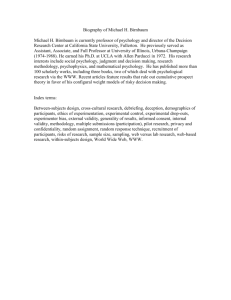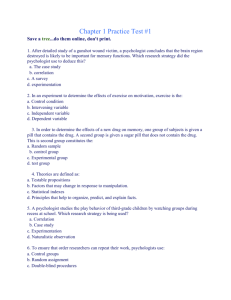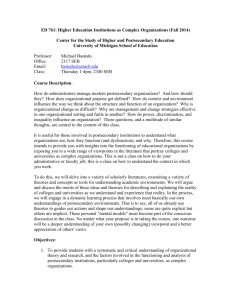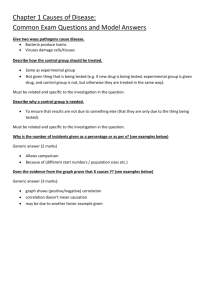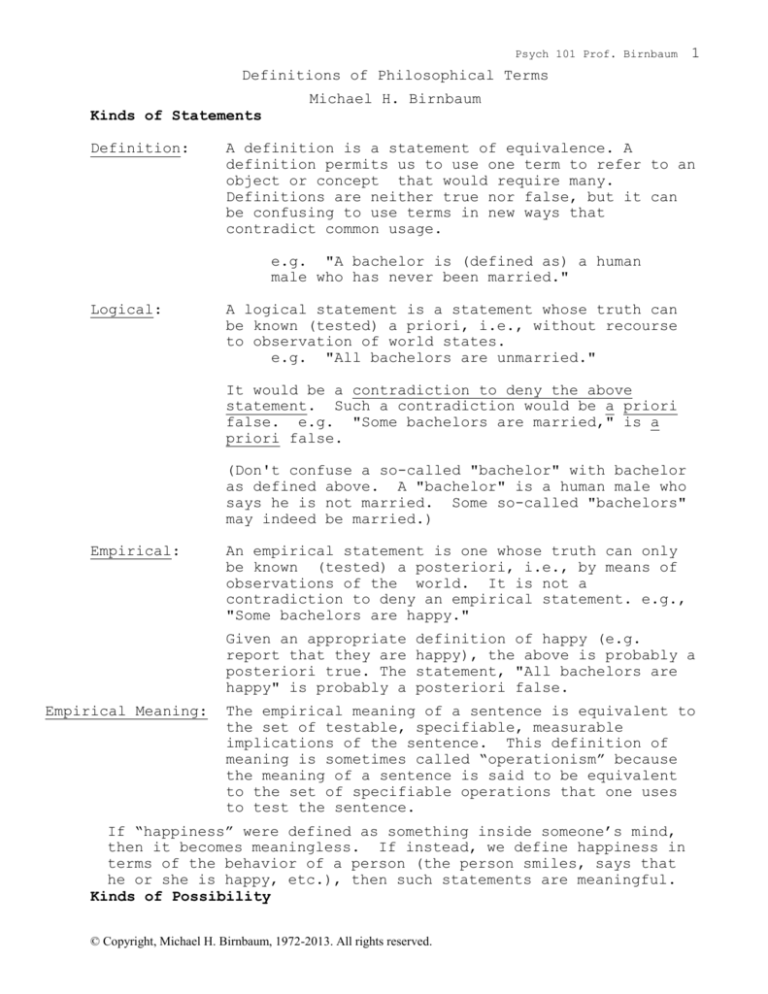
Psych 101 Prof. Birnbaum
1
Definitions of Philosophical Terms
Michael H. Birnbaum
Kinds of Statements
Definition:
A definition is a statement of equivalence. A
definition permits us to use one term to refer to an
object or concept that would require many.
Definitions are neither true nor false, but it can
be confusing to use terms in new ways that
contradict common usage.
e.g. "A bachelor is (defined as) a human
male who has never been married."
Logical:
A logical statement is a statement whose truth can
be known (tested) a priori, i.e., without recourse
to observation of world states.
e.g. "All bachelors are unmarried."
It would be a contradiction to deny the above
statement. Such a contradiction would be a priori
false. e.g. "Some bachelors are married," is a
priori false.
(Don't confuse a so-called "bachelor" with bachelor
as defined above. A "bachelor" is a human male who
says he is not married. Some so-called "bachelors"
may indeed be married.)
Empirical:
An empirical statement is one whose truth can only
be known (tested) a posteriori, i.e., by means of
observations of the world. It is not a
contradiction to deny an empirical statement. e.g.,
"Some bachelors are happy."
Given an appropriate
report that they are
posteriori true. The
happy" is probably a
Empirical Meaning:
definition of happy (e.g.
happy), the above is probably a
statement, "All bachelors are
posteriori false.
The empirical meaning of a sentence is equivalent to
the set of testable, specifiable, measurable
implications of the sentence. This definition of
meaning is sometimes called “operationism” because
the meaning of a sentence is said to be equivalent
to the set of specifiable operations that one uses
to test the sentence.
If “happiness” were defined as something inside someone’s mind,
then it becomes meaningless. If instead, we define happiness in
terms of the behavior of a person (the person smiles, says that
he or she is happy, etc.), then such statements are meaningful.
Kinds of Possibility
© Copyright, Michael H. Birnbaum, 1972-2013. All rights reserved.
Psych 101 Prof. Birnbaum
2
Logically possible: If an empirical statement is not a
contradiction, it is logically possible. e.g.
"I can fly to the moon and back without a
spaceship in .02 seconds."
Logically impossible: A contradiction of definition and
meaning. It is not logically possible for a
bachelor to be married. It is logically
possible for a bachelor to fly faster than the
speed of light.
Empirically possible: Consistent with the laws of nature
(whatever they may be). We believe it is
empirically possible to fly at a velocity of
1,000 miles/hour but not at a velocity of
10,000,000 miles per sec. It is not always
obvious what is empirically impossible.
Opinions or beliefs about empirical possibility
change over time.
Empirically impossible: Contradicts the laws of nature. We
think it is empirically impossible to transport
a human to the sun and back in less than .01
sec without a spaceship.
Technically possible: A possibility that can now be achieved
given the current state of technology. It was
once technically impossible to fly to the moon,
but it became technically possible in the
1960s. We assume it has always been
empirically possible.
Technically impossible: It is now assumed to be technically
impossible for a human to live more than 150
years. (No one has done it).
Meaningful vs. meaningless statements
A meaningful statement can, in principle, be tested by
operations that can be specified. The meaning of an empirical
statement is equivalent to the set of implications for tests of its
truth status by means of specifiable operations. If a statement
has no implications (i.e., there are no tests or observations to
make that might in principle refute the statement), then it is
meaningless.
e.g., “On the far side of the moon there is a 7-up bottle cap.”
Even though we cannot easily test this statement, it is logically
possible to do so. We can imagine, for example, traveling to the
moon and looking for the bottle cap. We understand the outcomes
(finding it or not).
However, consider the following:
e.g., "Jack perceives red colors in his mind the way Jill perceives
© Copyright, Michael H. Birnbaum, 1972-2013. All rights reserved.
Psych 101 Prof. Birnbaum
3
green, but both have learned the appropriate names to call them."
By definition, the contents of minds are considered private; that
is, they are assumed to be logically impossible to observe.
Therefore, it would be a contradiction to claim to observe Jack's
or Jill's mind and thus the statement has no empirical implications
and is thereby meaningless. It does have a certain poetic meaning.
Induction and Deduction
Deduction is an argument based on logical derivation of
conclusions from premises.
e.g. (P1) Socrates is an Athenian.
(P2) All Athenians are Greek
(C)
Socrates is a Greek.
If the premises are true (and one shouldn't need to add--the
deduction is logical--true deduction is always logical) then
the conclusion is true. If the conclusion is false, then the
premises have a problem. If the premises are false, the
conclusion may or may not be false. If the conclusion is
true, the premises may or may not be true.
Induction:
An inductive argument is used to establish an empirical
generalization (such as a correlational or causal
statement). The argument is based on the assumption that
instances obtained at one time are samples of a
population of instances that includes past and future
events. The principle of induction asserts that if the
proposition, :AB, has successfully been tested on n
occasions, the credibility that will hold an occasion n
+ 1 is increased as n increases.
Note: (Empirical induction should not be confused with mathematical
induction which is actually a type of deduction).
e.g. : If you drop a pen near the surface of the Earth (A),
it falls (B).
The association AiBi has held on over 1000 tests. To
date, A with not B has never occurred. Therefore, if we
drop a pen tomorrow, it seems believable that it too will
fall.
© Copyright, Michael H. Birnbaum, 1972-2013. All rights reserved.
Psych 101 Prof. Birnbaum
4
Causation vs. Correlation
Correlation is a relationship between two events. A correlational
proposition states that events co-occur. If A and B are
correlated, one can be used to predict the other. By
induction, it may be argued that events shown to co-occur
in the past will also co-occur in the future, a
correlational generalization.
e.g. The death rate due to starvation in India is correlated with
the number of ice cream cones sold in New York City. The
number of traffic accidents in a city is correlated with
the number of telephones in the city.
Yearly economic indicators are correlated with the
average length of women's skirts.
Evidence for a correlation statement should not be used as
evidence for causation. Remember, correlation is the
tool of the Devil!! Correlations are useful for
prediction, but not for testing causation.
Causation: The statement A causes B implies that if A is caused to
occur independently of other factors, then B will occur. If A1
causes B and A2 causes B, then A1 and A2 are said to be
"sufficient" for the occurrence of B. If A1 and A2 are required
for the occurrence of B and if it can be shown that without A1,
then B will not occur, then A1 is said to be "necessary" for the
occurrence of B.
Causal statements are tested by experiments in which the
suspected cause (A) is manipulated so as to make it independent
of all other factors (this is often done by using a random
process to control A or not A). The independent variable (e.g.
A vs. not A) is manipulated and the occurrence of the suspected
effect B (the dependent variable) is measured.
e.g. The Cambridge-Somerville Youth Study investigated whether
psychotherapy caused a reduction in the probability of being
convicted of crimes. Six hundred boys who had been identified
as potential delinquents were randomly assigned to one of two
groups by the toss of a coin. The treatment group received
counseling and psychotherapy. The control group did not receive
treatment. An equal proportion of boys were convicted of
crimes. Boys in the treatment group actually were more likely
to commit two or more crimes, and the probability of obtaining a
difference this large by random assignment, given the null
hypothesis of no difference, was less than .05. McCord
(American Psychologist, 1978) in a thirty-year follow-up of the
two groups concluded that the evidence indicated that
psychotherapy was harmful, according to seven criteria of harm
(age of death, criminal convictions, disease, alcoholism,
occupational status, mental illness, and job satisfaction).
In this example, treatment vs. no treatment was the
independent variable, and there were many dependent variables
including criminal convictions, age at death, signs of
alcoholism, signs of mental illness, blood pressure/heart
© Copyright, Michael H. Birnbaum, 1972-2013. All rights reserved.
Psych 101 Prof. Birnbaum
5
trouble, prestige of occupations, and rated satisfaction of
work.
Homework on Philosophical Terms
(Study definitions of Philosophical Terms; Study lecture notes and
Ch 1-2 of by Kalat. Huff’s book has examples of causation vs.
correlation, discussed in chapter 8 titled "Post hoc rides again.")
Define and give original examples of the following concepts:
definition
operational definition
logical statement
a priori true
a priori false
empirical statement
a posteriori true
a posteriori false
meaningless sentence that sounds like an empirical
statement
induction
deduction
correlation statement
evidence for correlation
causal statement
evidence of causation
Study ideas: After you have written your own examples, get
together with a classmate or two and discuss your examples.
Be sure to give clear definitions; otherwise your examples may
be unclear.
Thought questions for this segment of the course:
1.
2.
3.
4.
5.
6.
7.
What is the status of Freud's psychoanalysis as a theory?
Does it satisfy the philosophical criteria of a theory?
A. What are the major types of biological
psychotherapies? B. What are the major types of
“psychological” therapies?
How would you evaluate a new type of psychotherapy?
Is there any proof that any type of psychotherapy is
beneficial?
What is the Barnum effect?
How are mental illnesses like medical illnesses? How are
they different?
How accurate are clinical predictions of behavior?
To learn more: Any book on Introduction to Philosophy should have
sections on the topics of definition, meaning, causation and correlation.
For example: Hospers, J. (1953). An introduction to philosophical analysis. Englewood Cliffs, NJ:
Prentice-Hall, Inc.
© Copyright, Michael H. Birnbaum, 1972-2013. All rights reserved.
Psych 101 Prof. Birnbaum
Statistics Formulae
Score on Variable X for case i:
Xi
Mode = Value of X that is most frequent
Median = Value of X for which 50% of the cases are smaller
Midpoint = ( X MAX X MIN ) / 2
Range = X MAX X MIN
n
Mean of Variable X, based on n cases:
X
X
i 1
i
n
n
(X
Variance of Variable X:
s X2
Standard Deviation of Variable X:
s X s X2
Standard Score of case i on Variable X:
zXi =
i 1
i
X )2
n
Xi - X
sX
Areas under Normal Distribution:
Standard Normal Distribution
.34
Probability Density
0.40
0.30
.50
.135
0.20
0.10
0.00
.025
-4
-3
-2
-1
0
1
2
Standard Score (z)
Area from -1 to 1: .68
Area from -2 to 2: .95
© Copyright, Michael H. Birnbaum, 1972-2013. All rights reserved.
3
4
6
Psych 101 Prof. Birnbaum
n
Correlation Coefficient between X and Y: rXY
z
i 1
Xi
zYi
n
Predictions of Y from X and X from Y: Regression Equations:
Y from X:
zYi = rXYzXi
X from Y:
zXi = rXYzYi
zYi = Yis- Y
The z-score of the predicted value is defined as:
Y
Note that correlation coefficient is the slope of the
regression (prediction) equation on the zY vs. zX plot:
y = 0.71429x R^2 = 0.510
Predicting X from Y
3
2
Y
1
Predicting Y from X
0
-1
-2
-3
-3
-2
-1
0
X
1
2
3
residual = Yi - Yi
+
residual (error)
+
(Yi - Yi)
Errors (Residuals) of Prediction:
score =
predicted
=
Yi
Yi
Total Variance = Variance Predicted + Variance of Residuals
s 2Y
r2XYs2Y
(1 - r2XY)s2Y
=
+
1 - r2XY
r2XY
Proportions:
That is, the average squared error (predicting Y from X):
n
sY2 Yˆ
(Y
i 1
i
Yˆi ) 2
n
2
(1 rXY
) sY2
Standard deviation of residuals (errors predicting Y from X):
sY-Y = (1 - r2XY)s2Y
© Copyright, Michael H. Birnbaum, 1972-2013. All rights reserved.
7
Psych 101 Prof. Birnbaum
8
Statistics, IQ, and Personality Testing Homework
Be sure to study chapters in Kalat covering IQ, statistics, and personality testing, Huff's book,
and class notes. Do #22 first (memorize the equations), then do items in order. See what you
can do without looking at notes. Then study notes and books again, and try again.
1.
Draw a frequency distribution of these 11 numbers: 0, 0, 1, 1, 5, 6, 7, 0, 9, 10, 30
2.
Find the mean, median, mode, and midpoint of the numbers in No. 1.
3.
What is the shape of the distribution in No. 1? Is it symmetric or asymmetric? Is it skewed?
If it is skewed, is it positively or negatively skewed.
4.
Find the mean, variance, and standard deviation of the following numbers: 10, 20, 30, 40,
30, 20, 50, 30, 30, 20, 40, 30, 40, 30.
5.
Draw a frequency distribution for the numbers in No. 4.
6.
Describe the shape of the distribution in No. 4-5. Find the median, mode, midpoint, and
range.
7.
Find the z-score of each value in No. 4.
8.
Suppose a job placement test is normally distributed with a mean of 50 and a standard
deviation of 15.
a.
What percent of applicants who take the test scored below 80?
b.
What percent scored between 50 and 80?
c.
What percent score below 40? (Hint: if you can't find the answer exactly,
approximate).
d.
Suppose you need to be in the top 25% to be hired. What score do you need?
© Copyright, Michael H. Birnbaum, 1972-2013. All rights reserved.
Psych 101 Prof. Birnbaum
9.
Here are some data from a study of the reliability of a projective test. The test was given
twice to 14 patients, once each by two different clinical psychologists. The test is supposed
to measure degree of neurosis. X = the first test score, Y = the second score. Compute the
correlation coefficient between X and Y. Hint: both means are 30, both standard deviations
are 10.
zXi
zYi
zXizYi
X1 = 30
X2 = 30
X3 = 10
X4 = 50
X5 = 30
X6 = 30
X7 = 20
X8 = 40
X9 = 30
X10 = 30
X11 = 20
X12 = 40
X13 = 20
X14 = 40
Y1 = 10
Y2 = 50
Y3 = 30
Y4 = 30
Y5 = 20
Y6 = 40
Y7 = 30
Y8 = 30
Y9 = 20
Y10 = 40
Y11 = 30
Y12 = 40
Y13 = 20
Y14 = 30
10.
Draw a correlation scatterplot for the data in No. 9. Look again at Kalat's example
scatterplots of correlations.
11.
Is the test reliable? Discuss.
12.
Is the test valid? Discuss. Should these scores be admitted as evidence in court?
13.
Should this test be used to measure the outcome of a therapy experiment? Discuss.
© Copyright, Michael H. Birnbaum, 1972-2013. All rights reserved.
9
Psych 101 Prof. Birnbaum
14.
10
Suppose the correlation between parent and child's IQ is .50. Suppose both IQ distributions
are normal with means of 100 and standard deviations of 15.
a.
b.
c.
d.
e.
Predict the child's IQ if the parent's IQ = 70.
Predict the child's IQ if the parent's IQ = 85.
Predict the child's IQ if the parent's IQ = 100.
Predict the child's IQ if the parent's IQ = 115.
Predict the child's IQ if the parent's IQ = 130.
15.
Predict the parent's IQ if the child's IQ = 130.
16.
Keeping the same assumptions as above, find the distribution of children's IQs for parents
with IQs of 70, 85, 100, 115, and 130.
a.
For each type of parent, estimate the probability that a child will have a higher IQ than
the parent.
b.
For each type of parent, find the probability that a child will have IQ > 100.
c.
17.
Suppose the correlation between IQs of husbands and wives is .6. Work out the
distribution of the IQs of the husbands of women whose IQs = 130. Why do bright
women rarely have husbands as smart as they are?
Suppose the correlation between IQ at age 8 and IQ at age 12 is 2/3, the correlation between
ages 12 and 16 is also 2/3, and the correlation between IQs at ages 8 and 16 is 1/3. Hint: it
will help to keep these correlation coefficients as fractions, rather than convert them to
decimal equivalents.
a.
Suppose we pick children who at age 8 have IQs of 70. Predict their average IQ at
age 12 and at age 16.
b.
Suppose we pick children at age 8 whose IQs are 130. Predict their mean IQs at age
12 and 16.
c.
What do the results of a and b above suggest for before-after studies of remedial
teaching or studies of gifted programs?
d.
Suppose we pick children at age 16 whose IQs = 70. What were their mean IQs at
ages 8 and 12?
e.
Suppose we pick children at age 16 whose IQs = 130. What were their mean IQs at
ages 8 and 12?
f.
What do the results of d and e tell us about retrospective studies of gifted or retarded
people? How does this statistical issue relate to the discussion of gifted people in the
text?
© Copyright, Michael H. Birnbaum, 1972-2013. All rights reserved.
Psych 101 Prof. Birnbaum
18.
19.
11
Discuss the following issues concerning the IQ test.
a.
What is the relationship between mental age and IQ for children? Why isn't
chronological age used to define IQ for adults?
b.
What is the reliability of the test? How is it measured? What is the typical value of
the reliability coefficient?
c.
What is the validity of the test? How is it measured? What are the typical results.
Cite evidence.
d.
What biases exist in the test? Cite evidence (not theory) for bias.
Complete the following table. Be sure to study the appropriate sections in the textbooks.
What are the actual correlation coefficients in IQ, according to empirical studies?
a.
Test-retest
b.
Alternate forms reliability
c.
IQ with SAT
d.
Husband's IQ by wife's IQ
e.
Parent-child, reared apart
f.
Parent-child, reared together
g.
Unrelated, reared apart
h.
Unrelated, reared together
i.
DZ (fraternal) twins, reared together
j.
DZ (fraternal) twins, reared apart
k.
siblings, reared together or apart
l.
MZ twins, reared together
m.
MZ twins, reared apart
20.
Describe the evidence concerning the heredity-environment debate. Are IQ scores
determined mostly by heredity or environment? Cite evidence, not theory. Be sure to cite
adoption studies, environmental intervention studies, and twin studies.
21.
Compare the reliability and validity of the IQ test with those of the Projective tests, the
MMPI, and personality tests like the CPI. Discuss the Barnum effect and the results of the
clinical vs. statistical prediction literature.
22.
Make sure you know the definitions and formulas for the following by heart.
a.
Mean, Median, Mode, Midpoint
b.
Shapes of distributions - positive and negative skews, symmetric
c.
Variance and standard deviation
e.
Standard score (z-score)
f.
Normal distribution (Areas: -2, -1, 0, 1, 2)
g.
Correlation coefficient
h.
regression-prediction equation
i.
error of regression
j.
reliability, validity
k.
definition of test bias
l.
IQ = 100MA/CA
© Copyright, Michael H. Birnbaum, 1972-2013. All rights reserved.

